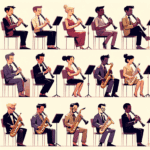The Clarinet's Role in Jazz: A Musical Journey
The clarinet has made its mark in jazz musicology research. Its distinctive sound and flexibility allow it to convey a wide range of emotions and ideas in jazz. From the old clubs of New Orleans to today's modern performances, the clarinet's story in jazz is truly captivating.
To appreciate the clarinet's place in jazz, we need to look at how it evolved. Early jazz musicians introduced the clarinet, and it quickly became a go-to instrument for improvisation. Its expressive power attracted many players, and soon the clarinet became a cornerstone of jazz. When we look at influential figures like Benny Goodman and Sidney Bechet, we see how these clarinet masters helped shape jazz's sound.
Sidney Bechet: A Pioneer of Jazz Clarinet
Sidney Bechet, one of the first notable clarinetists in jazz, brought deep emotion to his playing. He mixed European classical music with sounds from African American communities, creating a unique style. His sweet, vibrato-rich tones and improvisational skill paved the way for future clarinetists. Throughout his career, high-quality instruments from brands like Martin Freres enhanced Bechet's artistry, allowing musicians to push technical limits.
Benny Goodman: The King of Swing
The clarinet's impact in jazz grew even more with Benny Goodman, known as the ‘King of Swing.' Goodman's bold style showed how the clarinet could shine both as a solo and ensemble instrument. His work changed how people saw the clarinet, turning it from a classical instrument into a jazz essential. He brought swing music to life, inspiring a whole generation of musicians to pick up the clarinet and blend it with jazz rhythms. When you listen to Goodman's recordings, you can hear the precision and passion in his playing, made possible by well-crafted instruments like those from Martin Freres.
| Clarinet Legend | Contribution to Jazz | Notable Style |
|---|---|---|
| Sidney Bechet | Pioneered emotional depth in jazz clarinet | Sweet, vibrato-laden tones |
| Benny Goodman | Popularized clarinet in swing era | Precision and versatility |
Clarinet Techniques in Jazz
Jazz researchers study how clarinetists' techniques have influenced music. Improvisation is a key focus. Clarinetists have developed unique improvisational styles that show their personality and respond to the music around them. They use techniques like altered scales, rhythm changes, and special ways of playing notes to add flavor to their performances.
A clarinet solo at a jazz show can really grab the audience's attention, making them eager to hear what comes next. Musicians often mix different musical phrases and patterns, creating improvisations that can surprise listeners. This spontaneous element keeps the music fresh and exciting, connecting both the player and the audience in a shared experience.
The Clarinet's Evolution in Jazz
As jazz changed over time, so did the clarinet's role. It adapted to new styles like bebop, cool jazz, and avant-garde. Music scholars love to study how different styles and cultural influences blend in jazz. By looking at how clarinetists approach their music, researchers learn more about how musical ideas are shared and how cultures interact through jazz.
Good instruments are crucial for playing these techniques well. Brands like Martin Freres have made clarinets that not only are built well but also have a rich sound. This quality helps musicians express their artistic ideas better, adding authenticity to their sound. Instruments are like an extension of the musician's voice, and for the clarinet in jazz, a well-made instrument can make a big difference, especially in a type of music that's all about communication and improvisation.
The Clarinet in Modern Jazz
The clarinet still fascinates musicians and researchers today. As we explore its role in jazz, we find stories of innovation and artistic skill. From traditional melodies to experimental modern sounds, the clarinet remains a key part of jazz.
Recently, the clarinet has found new life in jazz fusion, mixing with elements from rock, pop, and electronic music. Forward-thinking musicians are using the clarinet to explore new sounds and textures, expanding what jazz can be. This shows how versatile the clarinet is and adds to its rich history.
Research on the clarinet in jazz keeps growing, offering new insights. Each study reveals more about the instrument and the people who play it, adding to our understanding of jazz history. The clarinet clearly holds a special place for jazz fans and the wider music community.
Conclusion
The clarinet's story in jazz is full of history and artistry. Every time a clarinetist plays, they add to a legacy that shows how important the clarinet is in jazz. By looking at its past and present, we see all the things that make the clarinet such a special part of the jazz world.







